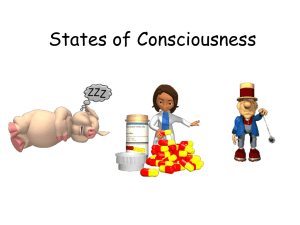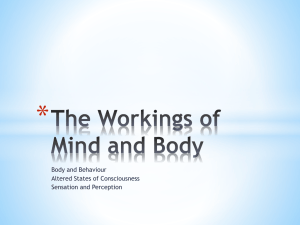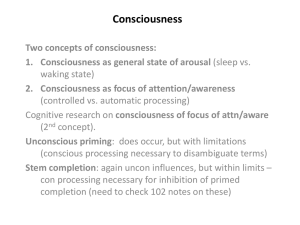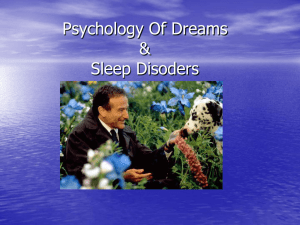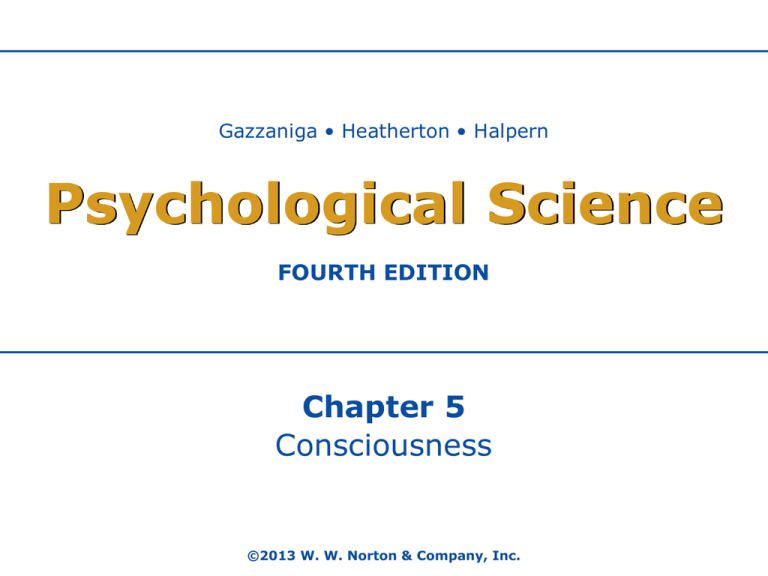
Gazzaniga • Heatherton • Halpern
Psychological Science
FOURTH EDITION
Chapter 5
Consciousness
©2013 W. W. Norton & Company, Inc.
Consciousness
• Erik Ramsey is “locked in…”
• Suffered traumatic injury to his brain as the
result of an automobile accident
• He can see, hear and feel, but he cannot move
or communicate with the outside world…at
least not yet
Consciousness
• In a coma, but aware
• Patterns of brain activity in a coma sufferer
were similar to patterns found in those not in
a coma (Owen et al., 2006)
• Communication may be possible with coma
patients previously believed to be
unreachable
5.1 What Is Consciousness?
Learning Objectives
• Define consciousness.
• Identify varied states of consciousness.
• Summarize research findings on consciousness
and “the interpreter” among individuals with
split brain.
• Discuss how unconscious processes influence
thought and behavior.
What Is Consciousness?
• People can be conscious even when they
appear not to be
• All conscious experience is associated with
brain activity
• Variations in consciousness occur naturally
• Consciousness can be manipulated
• Conscious experience varies from person to
person
Consciousness Is a
Subjective Experience
• Consciousness: The subjective experience of
the world, resulting from brain activity
• The brain and the mind are inseparable
• Each of us experiences consciousness
personally
• We cannot know if two people experience the
world in exactly the same way
There Are Variations in
Conscious Experience
• Sleep/wake cycle
• Automatic tasks
– Driving, walking, catching a baseball
• Controlled processing
– Helps us perform in complex or novel situations
Extreme States
• Conditions of impaired consciousness provide useful
points of contrast to “normal” (fully-functioning)
consciousness
• Persistent vegetative state
• Full coma that lasts more than a month
• Terri Schiavo
• Minimally conscious state
• Deliberate movement and communication are possible
• Jan Grzebski
Brain Activity Gives Rise
to Consciousness
• Psychologists can examine and measure
consciousness (e.g., fMRI)
• Consciousness arises from brain circuits’
activity
The Global Workplace Model
• In some cases brain-injured patients are
unaware of their deficits (“hemineglect”)
• Consciousness arises through brain processes
that are active at any point in time
• No single area of the brain responsible for
general “awareness”
The Split Brain
• Awareness of the world is associated with
functioning in different parts of the brain
The Split Brain
• Corpus callosum removed
• Two halves of the brain cannot receive
information directly from each other
• Studies show the relation between specific
brain regions and conscious experience
• Early observations were that split-brain
patients had no discernable problems
• Sperry & Gazanniga’s (1960s) research proved
otherwise
The Split Brain
• Language center located in left hemisphere
• Split brain patients cannot report on an object
presented in their left visual field
• They could correctly choose the object (with their
left hand)
• Right hemisphere handles spatial tasks
• Split-brain patients could not arrange blocks
correctly when using their right hand
• Left-handed, the task was effortless
The Interpreter
• The left hemisphere attempts to make sense
of right-hemisphere actions
The Interpreter Speculates
• The left hemisphere tries to make sense of
the world (e.g., imposing narrative structure,
seeking patterns)
• The right hemisphere simply experiences the
world
• Brain hemispheres work together to construct
our experience of the world
Unconscious Processing
Influences Behavior
• We are aware of some mental processes and
unaware of others
• Subliminal perception: Processing information by
sensory systems without conscious awareness
• Freudian slip: An unconscious thought expressed
at an inappropriate moment
• Stereotype activation: Is it automatic?
– Bargh et al. (1996) found research participants primed
with stereotypes about the elderly unconsciously
behaved in ways consistent with those stereotype
The Smart Unconscious
• Good advice: “You’d better sleep on it.”
• Unconscious processing of problems can lead
to superior solutions (Dijksterhuis, 2004)
• Even conscious thinking can undermine good
decision- making (Wilson & Schooler, 1991)
5.2 What Is Sleep?
Learning Objectives
• Describe the stages of sleep.
• Identify common sleep disorders.
• Discuss the functions of sleep and dreaming.
What Is Sleep?
•
•
•
•
•
Sleep is biologically regulated
Circadian rhythms
Melatonin secretion linked to light-dark cycles
Some adults report needing 7-9 hours a night
70-year-old “Miss M.” gets by on one hour per
night!
Sleep Is an Altered State
of Consciousness
• Sleep: Awareness of the outside world is
turned off (mostly)
• So why don’t we fall out of bed?
• EEG: The brain is active in sleep
Stages of Sleep
•
•
•
•
Sleep is not an “on-off” event
Sleep stages
Historically: 5 distinct stages
Currently: Stages 3 & 4 are now joined
REM Sleep
• The sleep cycle reverses after about 90
minutes
• Enter REM (paradoxical) stage
• Most dreaming occurs in REM sleep
• Amount of time spent in REM increases
• Cycle through this pattern around 5 times per
night
Sleep Disorders
• Insomnia: Difficulty falling or staying asleep
• Obstructive Sleep Apnea: Breathing may stop
hundreds of times per night
• Narcolepsy: Sufferers unexpectedly fall asleep
• REM Behavior Disorder: Sufferers act out
their dreams
• Somnambulism: Sleep walking
Sleep Is an Adaptive Behavior
• Sleep serves important biological purposes:
– Restoration
– Circadian rhythms
– Facilitation of learning
Restoration and Sleep Deprivation
• Restorative Theory: Sleep allows the body to
rest and repair itself
• The evidence:
– Sleep increases after strenuous physical activity
– Growth hormones secreted in sleep
– Replenishes the brain’s energy stores
– Strengthens the immune system
Restoration and Sleep Deprivation
Effects of sleep deprivation:
• Mood problems (e.g., irritability)
• Decrements in cognitive performance (e.g.,
attention and short-term memory lapses)
• May compromise the immune system
• Falling asleep for a few seconds to a minute
(microsleeps) can impair ability to perform
critical tasks (e.g., driving)
Circadian Rhythms
Circadian rhythm theory:
• Many creatures are quiet and inactive during
the night because darkness is the time when
danger is highest
• Reduced risk of exposure to predators
• Humans: Are adapted to sleep at night
because our early ancestors were more at risk
in the dark
Facilitation of Learning
Sleep: Strengthens neural connections needed for learning
to occur
• Research shows memory in participants who slept was
greater than those who didn’t (Drosopoulos, Schulze,
Fischer, & Born, 2007)
• REM and slow-wave (stages 3 & 4) important for learning
to take place
• Participants who completed a complex task and later
dreamed about it subsequently performed better on the
task than non-dreaming participants (Wamsley, Tucker,
Payne, Benavides, & Stickgold, 2010)
• Students spend more time in REM during exam periods
People Dream while Sleeping
• Dreams: Products of an altered state of
consciousness in which images and fantasies
are confused with reality
REM Dreams and Non-REM Dreams
• REM dreams: More likely to be bizarre and
include intense emotions, visual and auditory
hallucinations, and uncritical acceptance of
illogical events
• Non-REM dreams: Relatively dull (e.g., what
sweater should I wear?)
REM Dreams and Non-REM Dreams
Explanation:
• Non-REM: General de-activation of many
brain regions
• REM: Brain structures associated with
motivation, emotion, reward, vision are
active; pre-frontal cortex is not
What Do Dreams Mean?
Freud: Dreams contain hidden content that represents
unconscious conflicts
• Manifest content: The plot of a dream; the way the dream
is remembered
• Latent content: What a dream symbolizes; the material
that is disguised in a dream to protect the dreams from
confronting direct reality
• No scientific evidence that dreams represent hidden
conflicts or for the special symbolic meaning of dream
images
Activation-Synthesis Theory
The theory:
• The brain tries to make sense of random brain
activity that occurs during sleep by synthesizing
the activity with stored memories (Hobson et al.,
2000)
• Emotion centers (limbic system) in the brain are
active, which explains the intense emotions;
frontal cortices are not active, which explains the
uncritical acceptance of illogical events
Activation-Synthesis Theory
The critics:
• Dreams are not as chaotic as the activationsynthesis theory suggests (Domhoff, 2003)
• Often similar to “everyday life” waking
experience
Evolved Threat-Rehearsal Theory
• Thought question: Why do people often dream
about threatening events?
• Answer: Perhaps dreams help us prepare to cope
with real waking events.
• Dreams sometimes simulate threatening events
so that people can rehearse strategies for coping
(Revonsuo, 2000)
• Dreams may have adaptive value if rehearsal
helps us survive and reproduce
5.3 What Is Altered Consciousness?
Learning Objectives
• Discuss the effects of hypnosis and mediation
on consciousness.
• Define the concept of flow.
• Discuss the consequences of escaping the self.
What Is Altered Consciousness?
• Awareness varies naturally over the course of
the day
• Potentially altered by: hypnosis, meditation,
and immersion in an action (i.e., flow)
Hypnosis Is Induced
through Suggestion
• Hypnosis: A social interaction during which a person,
responding to suggestions, experiences changes in
memory, perception, and/or voluntary action
• Induction: Hypnotist makes a series of suggestions
• “You are becoming sleepy. Your eyelids are drooping”
• If all goes well, the subject(s) behave in ways consistent
with suggestions
• Hypnosis works primarily for people who are highly
suggestible (1 in 5 persons)
Theories of Hypnosis
• Sociocognitive Theory: Hypnotized subjects are
role-playing (i.e., acting how they believe
hypnotized subjects are supposed to act)
• Dissociation Theory: Hypnosis is a “trance-like”
state where conscious awareness is separated
from other aspects of consciousness
• Strongest evidence for dissociation theory:
Numerous studies show the analgesic effects of
hypnotic analgesia
Hypnosis for Pain
• Hypnotic analgesia: Clinical evidence shows
hypnosis can be used to treat immediate (e.g.,
surgery, burns) and chronic (e.g., arthritis,
cancer) pain (Patterson & Jensen, 2003)
• Self-hypnosis: Also be shown to be effective in
improving recovery from surgery
• Clinical evidence: Hypnosis doesn’t reduce
the sensation of pain, but rather alters our
interpretation (i.e., perception) of it
Meditation Produces Relaxation
• Meditation: A mental procedure that focuses attention
on an external object or on a sense of awareness
Effects of meditation:
• One study found greater stress reduction and attention
among participants who meditated compared to a
group that underwent relaxation training (Tang et al.,
2007)
• Another study showed that when participants were
made to feel sad, those who received meditation
training were less sad than those who had not (Farb et
al., 2010)
People Can Lose Themselves
in Activities
• We are unaware of most of what we think and
do…
• There are activities in which we can “lose
ourselves” and enter an altered state
Exercise, Religious Prayer,
and Flow
• Runner’s high: Involves a shift in
consciousness away from the self (endorphins
too) accompanied by euphoria
• Religious ecstasy: Directs attention away from
the self and toward spiritual awareness
• “Flow”: Total engagement in an act for its own
sake (not focused on reward or on escaping
one’s problems)
Escaping the Self
• Escapist behaviors include: drug and alcohol
use, excessive television viewing, surfing the
Web, texting, playing of video games (e.g.,
World of Warcraft)
• Purpose of escapist behavior: Distracts
people from their problems; helps them avoid
feeling bad about themselves
Escaping the Self
• Escapist behavior reduces self-awareness,
which can lead to:
– Lowered long-term planning (e.g., poor foresight)
– Reduced meaningful thought (e.g., less effective at
anticipating consequences of one’s actions)
– Lowered inhibitions
5.4 How Do Drugs Affect
Consciousness?
Learning Objectives
• Describe the neurochemical, psychological,
and behavioral effects of marijuana,
stimulants, MDMA, opiates, and alcohol.
• Identify physiological and psychological factors
associated with addiction.
How Do Drugs Affect Consciousness?
• Drugs have been used throughout history to
create altered states
• Around 250 million people use illicit drugs
each year (United Nations Office on Drugs and
Crime, 2009)
• Other widely-used drugs include alcohol,
prescription medications, caffeine and
nicotine
• Drugs are a mixed blessing
People Use—and Abuse—
Many Psychoactive Drugs
• Drugs are useful in the treatment of many
medical conditions, but recreational drug use
can have negative consequences
People Use—and Abuse—
Many Psychoactive Drugs
• Psychoactive drugs: Mind altering substances
that change the brain’s neurochemistry
(marijuana, cocaine, amphetamines, MDMA,
opiates)
• Drug effects: The effects of a particular drug
depends on which neurotransmitter system it
activates (e.g., methamphetamine acts on the
dopamine system)
Marijuana
• Most widely used illicit drug
• Not easily categorized as a stimulant, depressant, or
hallucinogen
• Produces a relaxed, contented mood, more vivid
perceptions
• Experienced users appreciate the effects more than
novices (Kuhn, Swartzwelder, & Wilson, 2003)
• Psychoactive ingredient: THC
• Operates at cannabanoid receptors
• Medical use is controversial
Cocaine
• Long history of use in the United States (CocaCola)
• Stimulant
• Users experience increased alertness, increased
confidence and sociability
• Increases dopamine levels at synapses
• Habitual use of cocaine in large quantities can
lead to paranoia, psychotic behavior, and violence
(Ottieger, Tressell, Inciardi, & Rosales, 1992)
Amphetamines
• Long history of use for weight loss, staying awake
• Seldom used for legitimate medical purposes
• Methamphetamine: World’s second most
commonly used illicit drug
• Increases dopamine production; blocks reuptake
• Damages brain structures responsible for
cognition, memory and emotion (Kim et al.,
2006; Thompson et al., 2004)
• Causes considerable physical damage
MDMA
• “Ecstasy” has gained in popularity since the
“raves” of the 1990s
• High school students’ use increased from 3.7% to
4.7% between 2009 and 2010 (National Institute
of Drug Abuse, 2010)
• Users feel energized and may hallucinate
• Lowers dopamine; increases/depletes serotonin
availability
• May produce depression, memory loss, difficulty
in completing complex tasks (Fischer et al., 1995;
Kalechstein et al., 2007)
Opiates
•
•
•
•
•
Used historically to relieve severe pain
Depressant
Heroin, morphine, codeine
Users experience analgesia, relaxation, euphoria
Highly addictive due to effects at opiate receptors
(pleasure) and dopamine receptors (increased
wanting of the drug)
• Long-term use can lead to attention and memory
problems (Gruber, Silveri, & Yurgelun-Todd, 2007)
Alcohol Is the
Most Widely Abused Drug
• On the one hand: Moderate drinking is an
accepted aspect of social interaction
• On the other hand: Alcohol is a major
contributor to many social ills…
• Spousal abuse
• Traffic fatalities
• Unsafe sex
• Loss of productivity at work
Gender Differences in Alcohol
Consumption across Cultures
• According to the World Health Organization,
when compared to women, men are twice as
likely to report:
– Binge drinking
– Chronic drinking
– Recent alcohol intoxication
• What accounts for observed gender differences?
– Women metabolize alcohol slower than men and can
get the same effects while consuming less
– Women’s drinking may be hidden/unreported
Expectations
• Many people drink because they believe alcohol
will have a positive effect on their emotions and
behavior:
– Improve social skills
– Enhance sexual pleasure
– Boost confidence and power
• Evidence for the power of learned beliefs:
Research participants who believed that they had
drank alcohol acted in ways consistent with
people who actually consumed it (Hull & Bond,
1986)
Addiction Has Physical and
Psychological Aspects
• Addiction: Drug use that remains compulsive
despite its negative consequences
• Physical dependence involves:
– Tolerance: Increasing amounts of a drug is needed to
achieve the intended effect
– Withdrawal: Physiological and psychological state
characterized by feelings of anxiety, tension, and
cravings for the addictive substance
• Psychological dependence involves: Drug
cravings without tolerance or withdrawal
Addiction’s Causes
Why do people become addicted?
Physiological:
• Activation of brain dopamine systems that play a
role in the pleasurable experience drugs create
and regions (the insula) that govern cravings
• Heredity may play a role (e.g., alcoholism)
Psychological:
• The “sensation-seeking” personality trait
• Social learning (e.g., “modeling” of drug use by
significant others)
Addiction’s Context
• We cannot ignore the effects of social and environment
context when explaining addiction
• Robins, Helzer and Davis (1975) conducted a largescale study of 898 U.S. soldiers during Vietnam War
• The researchers found widespread drug use (over 90%)
among U.S. soldiers
• 1 in 5 returned to the United States addicted to drugs
• Once home, approximately 95% of the addicts quit
using drugs
• Removed from the stress of combat, they no longer
needed drugs to escape



